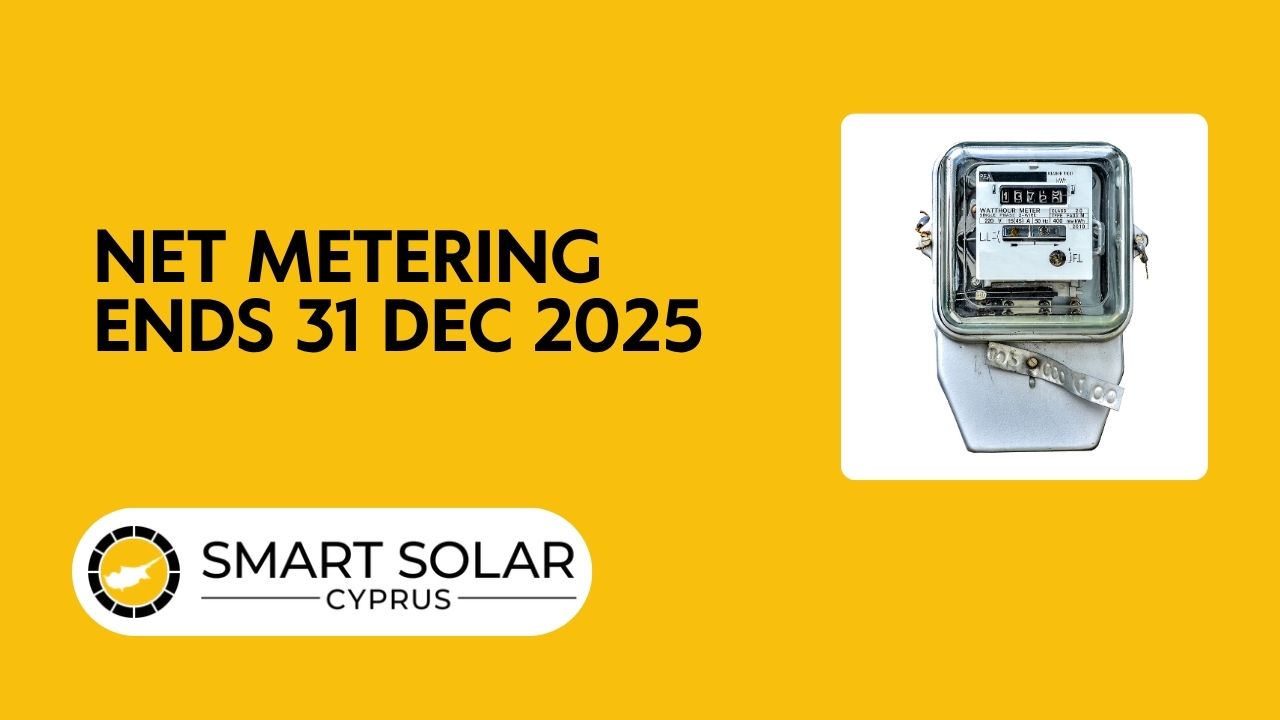Building a new home in Cyprus is the perfect opportunity to integrate solar power from day one. With electricity prices rising and sunshine levels among the highest in Europe, installing solar panels during the construction phase is no longer a luxury — it’s a smart financial and architectural decision. This guide explains everything homeowners, architects, and developers need to know: legal requirements, system sizing, roof design, wiring preparation, and expected ROI for new-build photovoltaic (PV) systems in Cyprus.
Why New Builds Should Include Solar Panels in Cyprus
Adding a PV system during construction provides several advantages over retrofitting it later:
1. Easier integration and lower installation cost
When solar is planned early, builders can prepare roof conduits, mountings, and electrical routing. This eliminates drilling, chasing walls, and structural reinforcing later. The result is a cleaner aesthetic, faster installation, and reduced labour costs.
2. Higher energy savings from day one
Most new homes in Cyprus include air-conditioning, pool pumps, underfloor heating, and electric water heaters — all large energy consumers. Having solar ready immediately helps offset these loads as soon as you move in.
3. Better architectural design
With early planning, architects can orient roof surfaces, avoid shading, and integrate battery storage areas neatly inside the technical room. A retrofit rarely achieves this level of precision.
4. Eligibility for net metering and government schemes
New homeowners can begin the application process for net metering or virtual net metering while the home is still under construction, speeding up approval timelines.
Is Solar Mandatory for New Builds in Cyprus?
As of 2025, Cyprus does not legally mandate PV panels for every new home.
However:
New-build homes must comply with EPBD energy-performance standards.
To pass energy efficiency certification, nearly all modern homes must include renewable energy integration — and solar PV is the easiest and most effective way to achieve compliance.
In practice:
Almost every new detached house in Cyprus includes a 3kW–5kW solar PV system by design, because it significantly improves the energy rating and reduces long-term electricity costs.
How Many Solar Panels Should a New Build Have?
The ideal system size depends on two factors:
1. Household electricity consumption
- Small homes / 1–2 occupants: 3kW system
- Medium homes / families: 4kW system
- Large homes with pools and underfloor heating: 5–7kW system
Typical annual consumption for a modern Cyprus household ranges between 6,000–9,000 kWh, depending on AC use.
2. Roof size and orientation
In Cyprus:
- A 4kW system needs around 18–20m² of roof space
- South-facing surfaces provide the best performance
- East/west roof faces also work if tilted correctly
- Shading from water tanks, chimneys, or nearby villas must be considered
Tip: During construction, keep water tanks low or place them on a side platform to avoid shading the PV area.
Best Solar Panel Types for New Builds in Cyprus
Cyprus experiences intense summer heat, coastal humidity, and dust. The best types of panels are:
1. Monocrystalline half-cell panels
These offer:
- High efficiency
- Better heat resistance
- Longer output warranty (20–25 years)
2. Tier-1 brands used in Cyprus
Common choices include:
- Jinko Solar
- LONGi
- JA Solar
- Canadian Solar
These brands maintain high performance even under the Cyprus climate’s 40°C+ summer temperatures.
Roof Design Requirements for Solar Panels
1. Orientation
The ideal roof slope is 10°–25° facing south.
However,:
- East/west roofs can still produce strong output
- Flat roofs require aluminium mounting frames, which are very common in Cyprus
2. Avoiding shade
New builds should factor in the position of:
- Solar water heaters
- AC compressors
- Parapet walls
- Neighbouring buildings
Even partial shade can drop output by 20–30%.
3. Structural load
A typical PV system adds 10–15kg per m².
Most new-build concrete structures in Cyprus already support this easily, but it should be included in the engineer’s structural plan.
Electrical Preparation During Construction
Preparing the electrical infrastructure during construction makes installation cheaper and cleaner.
1. Install a dedicated PV conduit
A PVC or metal conduit from roof to technical room allows:
- DC cabling
- Inverter wiring
- Potential battery wiring
2. Designate inverter placement
The best locations:
- Technical room
- Garage
- Utility room
Avoid direct sunlight and high humidity areas.
3. Add ventilation for hybrid inverters
Hybrid units (for battery systems) build heat. Pre-installed ventilation prevents performance drops.
4. Include battery space
If the homeowner may add a battery later, builders should allocate:
- 1–1.5m² floor space
- Cable route from inverter
- Fire-resistant wall backing (recommended)
This ensures the system is future-proof.
Net Metering for New Homes
Most new builds in Cyprus use net metering, where:
- You produce electricity during the day
- You receive credits to offset consumption at night
- Your bill reflects the net difference
Benefits for new builds
- Immediate bill reduction once you move in
- Predictable long-term cost savings
- Easy integration with hybrid inverters if you add a battery later
Approval usually takes 4–6 weeks, but submitting documents during construction speeds up activation.
Expected Energy Savings & ROI for New Builds
Solar PV systems in Cyprus offer one of the fastest returns in the EU.
Typical ROI in Cyprus
- 3kW system: 3–4 years
- 4kW system: 3–4.5 years
- 5kW system: 4–5 years
Savings depend on usage patterns, but here’s an example:
Example: 4kW PV System ROI
- Output: ~6,500 kWh/year
- Electricity cost: €0.30 per kWh
- Annual savings: ~€1,950
- System cost: €5,500–€6,800
- Payback: 3.2–3.7 years
After payback, electricity costs remain significantly lower for the next 15–20 years.
Should New Builds Include a Battery?
Battery storage is optional but beneficial for:
- Homes with high night-time usage
- EV charging
- Frequent power cuts (rural areas)
A battery can increase self-consumption to 70–90%, but raises the upfront cost.
Recommendation:
Install a hybrid inverter during construction so a battery can be added later without rewiring the system.
Checklist for Architects & Homeowners
Before construction:
- Choose ideal roof slope and direction
- Reserve unshaded roof area
- Add wiring conduits
- Decide inverter and battery locations
During construction:
- Run DC/AC cabling
- Install roof mounting reinforcements if needed
- Ensure technical room ventilation
After completion:
- Submit net metering application
- Finalise system design based on lifestyle needs
Final Thoughts
Solar panels are one of the most valuable upgrades you can integrate into a new home in Cyprus. With careful planning during construction, homeowners can achieve maximum efficiency, a clean installation, lower costs, and an ROI of just a few years. Given Cyprus’ unbeatable sunshine levels and rising electricity prices, a well-designed PV system is not only smart — it’s practically essential for modern home building.

How Much Money Can You Save With Solar?










